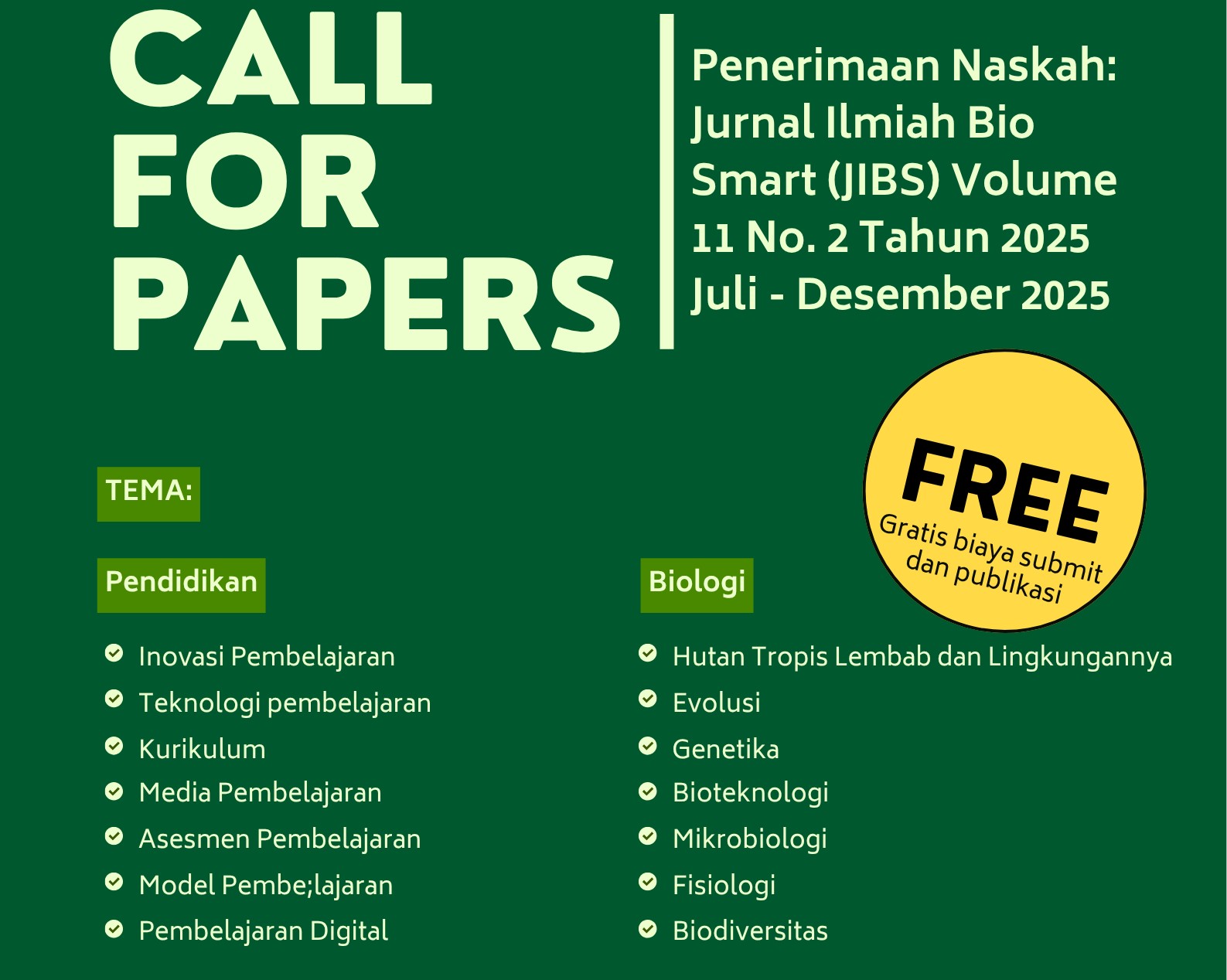The effectiveness of oshibana book development for class VII students of MTs Darissulaimaniyyah plant classification materials
DOI:
https://doi.org/10.30872/jibs.v7i2.660Keywords:
Keywords: Effectiveness, Oshibana Book, Plant Classification MaterialsAbstract
This study aims to determine the effectiveness of the Oshibana book in science learning for seventh grade students of MTs Darissulaimaniyyah Plant Classification material. The research method used in this study is Research and Development (RnD) using the ADDIE model, which consists of five stages: Analyze, Design, Development, Implementaion and Evaluation. The effectiveness of the Oshibana book was measured through a feasibility test, a readability questionnaire and a trial to students using pre-test and post-test questions. The feasibility test for the Oshibana book was carried out by three validators, namely material expert validators, media expert validators and seventh grade science teachers at MTs Darissulaimaniyyah. The product trial design for students uses Quasy Experiment using amodel non equivalent control group design. The sample used was class VII B as the control class and class VII C as the experimental class, the sample was determined by purposive sampling technique.
Oshibana book development process which includes special needs analysis, curriculum analysis and preparation of Oshibana book design. The results of the special needs analysis showed that 53.06% of the seventh grade students of MTs Darissulaimaniyyah did not have special learning media to study Plant Classification material so that researchers tried to develop the Oshibana book, as many as 81.63% of students agreed that the Oshibana book was developed as a learning medium. The results of the curriculum analysis of Plant Classification materials are studied in KD 3.2 about classifying living things and objects based on observed characteristics, and KD 4.2 about presenting results on classifying living things and objects around based on observed characteristics. The process of compiling the Oshibana book consists of several components, namely: cover front, introduction, table of contents, list of pictures, learning outcomes, book contents (Plant Classification materials and Oshibana materials), assignments, how to use and care for Oshibana learning media, reference lists and cover back.
The results of the Oshibana book feasibility test by material experts obtained results of 72% with the criteria of being effective as a learning medium, the results of the assessment of media experts obtaining results of 81.67 with the criteria of being effective as a learning medium and the results of the assessment of the seventh grade science teacher obtaining results of 92% with the criteria very effective as a learning medium. The results of the readability test by students of MTs Darissulaimaniyyah obtained an average of 88.01% with the criteria of being very effective as a learning medium. While the results of the trial to the experimental class and control class students obtained a comparison of the average N-gain value of 0.6667 0.0185 which indicates that the average N-gain value in the experimental class using the Oshibana book is higher than the control class. who didn't use Oshibana's book. The test of the effectiveness of the Oshibana book was carried out using the Independent Sample Test, the results obtained were 0.00 0.05 indicating a significant difference. The results show that Oshibana's book is effective as a learning medium for studying Plant Classification materials.
Downloads
References
of Living Things as a Supplement to Integrated Science Learning Media for Class VII
MTs. Semarang: Semarang State University.
Arifin, Z. 2009. Educational Evaluation. Bandung: PT. Rosdakarya Youth.
Arrijani. 2005. Use of Herbarium Media, Botanical Cards and Plant Illustrations in
Mastering Lecture Materials. Tondano: FMIPA UNIMA.
Ashar. 2011. Creative Developing Learning Media. Jakarta: King Perindo Persaja.
Cahyadi, RA 2019. Development of ADDIE Model-Based Teaching Materials. Surabaya:
Surabaya State University.
Chaeruman. 2008. Developing a Learning System with the ADDIE Model. Jakarta: PT
Pemuda Rosdakarya.
Fitriyana, E. 2016. Development of Herbarium Sheet for Ferns (Pteridophyta) as a Media for
Learning Materials for Ferns in High School. Semarang: Semarang State University.
Hamzah, NL 2011. Communication & Information Technology Learning. Jakarta: PT. Earth
Literature.
Lutfiyah, F. 2018. Oshibana: Beautiful Handmade Indonesian Endemic Biodiversity Based.
Semarang: PGRI University Semarang.
Munadi, Yudhi. 2013. Learning Media. Jakarta: GP Press Group.
Oshibana, R. 2004. Oshibana The Art of Flower Arrangement Press From Japan. Bandung:
Demedia Pustaka.
Ranti, ES 2019. The Effect of Herbarium on Children's Creativity Development at Kasih Ibu I
PAUD outside Parit. Padang: Padang State University.
Ratnasari, RD 2017. Development of Herbarium as Learning Media for Low Plants. Jember:
Muhammadiyah University of Jember.
Rita Rahmariati, S. 2015. I-SETS (Islamic, Science, Environment, Technology And Society)
Learning on Student Learning Outcomes”, Anterior journal, Vol. 14, No. 2.
Sri Sudarmiyati, Tatik Chikmawati. 2016. History of Plant Taxonomy Classification and
Development. Surabaya: CV Sinar Mandiri.
Sugiyono. 2018. Qualitative Quantitative Research Methods and R&D. Bandung: Alphabeta.
Susilo, MJ 2015. Analysis of the Quality of Insectarium and Herbarium Learning Media for
Biology Subjects. Yogyakarta: Ahmad Dahlan University.
UNHAS, L. 2015. Format of Teaching Materials, Textbooks, Modules and Practice Guides.
Makassar: Hasanudin University.
Windayati, VP 2016. Development of Herbarium Learning Media on Plant Organ Materials at
SMPN 5 Rambah Hilir. Rokan Hulu: University of Paris Pengaraian.
Wirakusumah, M. 2018. Preserved Flower as an Alternative Flower Arrangement. Bandung:
Pasundan University Bandung.












